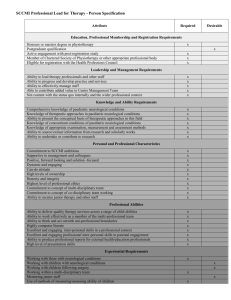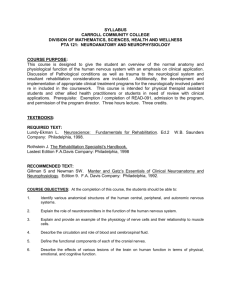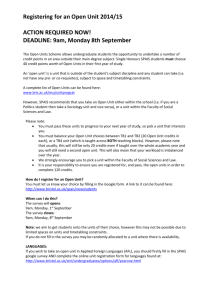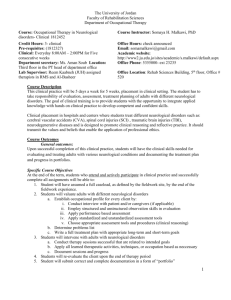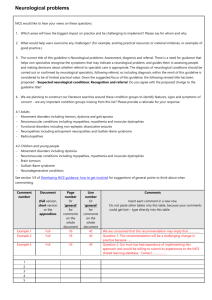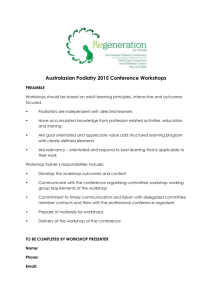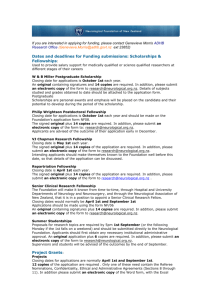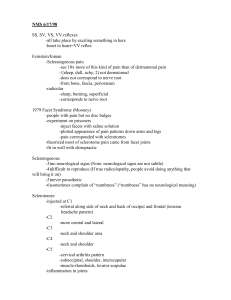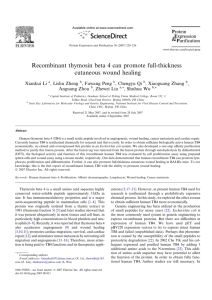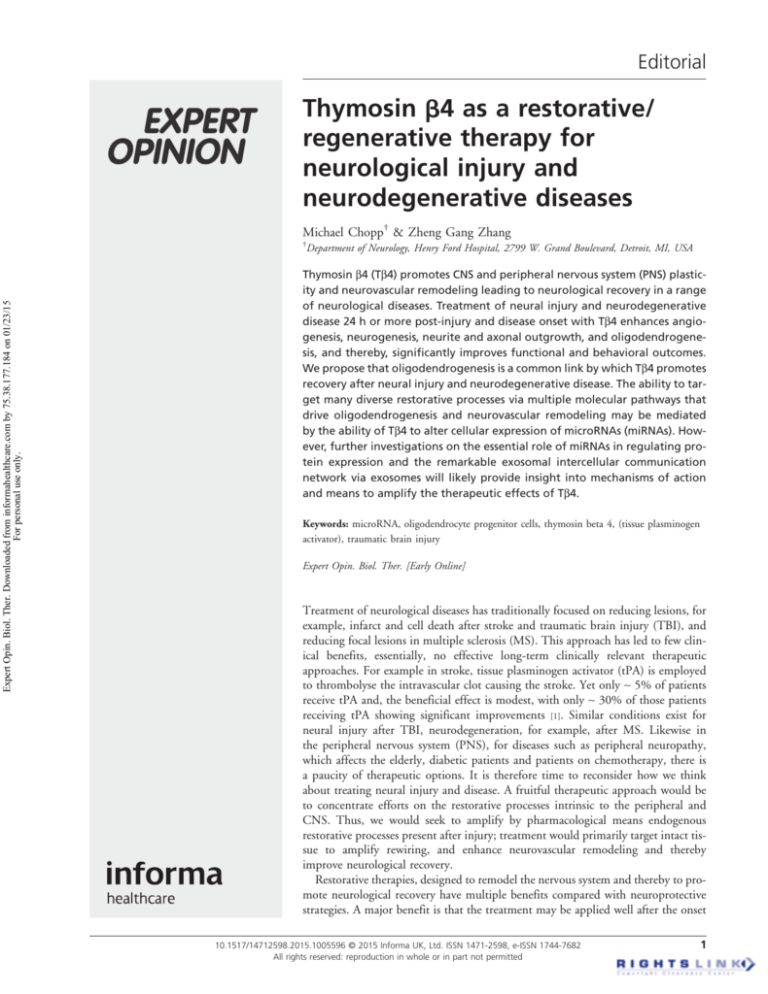
Editorial
Thymosin b4 as a restorative/
regenerative therapy for
neurological injury and
neurodegenerative diseases
Michael Chopp† & Zheng Gang Zhang
†
Expert Opin. Biol. Ther. Downloaded from informahealthcare.com by 75.38.177.184 on 01/23/15
For personal use only.
Department of Neurology, Henry Ford Hospital, 2799 W. Grand Boulevard, Detroit, MI, USA
Thymosin b4 (Tb4) promotes CNS and peripheral nervous system (PNS) plasticity and neurovascular remodeling leading to neurological recovery in a range
of neurological diseases. Treatment of neural injury and neurodegenerative
disease 24 h or more post-injury and disease onset with Tb4 enhances angiogenesis, neurogenesis, neurite and axonal outgrowth, and oligodendrogenesis, and thereby, significantly improves functional and behavioral outcomes.
We propose that oligodendrogenesis is a common link by which Tb4 promotes
recovery after neural injury and neurodegenerative disease. The ability to target many diverse restorative processes via multiple molecular pathways that
drive oligodendrogenesis and neurovascular remodeling may be mediated
by the ability of Tb4 to alter cellular expression of microRNAs (miRNAs). However, further investigations on the essential role of miRNAs in regulating protein expression and the remarkable exosomal intercellular communication
network via exosomes will likely provide insight into mechanisms of action
and means to amplify the therapeutic effects of Tb4.
Keywords: microRNA, oligodendrocyte progenitor cells, thymosin beta 4, (tissue plasminogen
activator), traumatic brain injury
Expert Opin. Biol. Ther. [Early Online]
Treatment of neurological diseases has traditionally focused on reducing lesions, for
example, infarct and cell death after stroke and traumatic brain injury (TBI), and
reducing focal lesions in multiple sclerosis (MS). This approach has led to few clinical benefits, essentially, no effective long-term clinically relevant therapeutic
approaches. For example in stroke, tissue plasminogen activator (tPA) is employed
to thrombolyse the intravascular clot causing the stroke. Yet only ~ 5% of patients
receive tPA and, the beneficial effect is modest, with only ~ 30% of those patients
receiving tPA showing significant improvements [1]. Similar conditions exist for
neural injury after TBI, neurodegeneration, for example, after MS. Likewise in
the peripheral nervous system (PNS), for diseases such as peripheral neuropathy,
which affects the elderly, diabetic patients and patients on chemotherapy, there is
a paucity of therapeutic options. It is therefore time to reconsider how we think
about treating neural injury and disease. A fruitful therapeutic approach would be
to concentrate efforts on the restorative processes intrinsic to the peripheral and
CNS. Thus, we would seek to amplify by pharmacological means endogenous
restorative processes present after injury; treatment would primarily target intact tissue to amplify rewiring, and enhance neurovascular remodeling and thereby
improve neurological recovery.
Restorative therapies, designed to remodel the nervous system and thereby to promote neurological recovery have multiple benefits compared with neuroprotective
strategies. A major benefit is that the treatment may be applied well after the onset
10.1517/14712598.2015.1005596 © 2015 Informa UK, Ltd. ISSN 1471-2598, e-ISSN 1744-7682
All rights reserved: reproduction in whole or in part not permitted
1
Expert Opin. Biol. Ther. Downloaded from informahealthcare.com by 75.38.177.184 on 01/23/15
For personal use only.
M. Chopp & Z. G. Zhang
of injury or the onset of clinical symptoms for degenerative
diseases. Neuroprotection by targeting the damaged tissue
must be applied before the target tissue undergoes irreversible
processes leading to cell death. The neuroprotection therapeutic window is measured at time scales of minutes or at most a
few hours post-damage [2]. Thus, treatment must be delivered
to the site of injury to reverse molecular cascades leading to
necrosis and apoptosis. The ability to deliver therapy to these
affected tissues faces a further complication of compromised
perfusion, abnormalities or lack of blood flow to systemically
deliver drug to reverse injury. In contrast, neurorestorative
agents that target intact tissue have a therapeutic window,
within the time span of days and weeks, since there is no
race against rapidly dying cells. Likewise, tissue perfusion
and blood flow to the target tissues are likely not compromised by the injury and therefore treatments whether cellbased or pharmaceutical-based may be effectively delivered
to the site of injury.
The therapeutic approach to stimulate endogenous neurorestorative processes has shown promise for the treatment of
stroke and TBI. Some of the very initial work on neurorestorative therapy for the treatment of neural injury and disease was
performed using cell-based therapy. Stem/progenitor cells
stimulate a set of highly interactive processes, such as angiogenesis, neurogenesis, oligodendrogenesis, synaptogenesis and
axonal outgrowth, which in-concert orchestrate neurological
recovery [3,4]. Cell-based therapy, for example, stimulates the
generation of angiogenic factors that promote vascular remodeling, and the activated and newly formed endothelial cells act
as a source of trophic factors, that also enhance neurogenesis
within the subventricular zone (SVZ) and neurite outgrowth.
The newly formed cells migrate from the SVZ to the region
of injury, interact with activated vasculature and differentiate
into neurons and oligodendrocytes (OLGs) [3-5]. This restorative tapestry of events creates a supportive environment for
neurovascular plasticity, neurite outgrowth and myelination
of axons. In addition, the stimulated and newly generated cells
release trophic factors that facilitate remodeling throughout
the nervous system. Thus, treatment of stroke and TBI with
cell-based or pharmacological-based restorative therapy promotes cortical spinal track remodeling and plasticity in the
spinal cord and contralateral and ipsilateral hemispheres,
which drive neurological recovery [3,6].
Thymosin b4 (Tb4) promotes remodeling of the CNS/PNS
post-neural injury and thereby improves neurological recovery
[7-10]. Tb4 expressed in nearly all mammalian cells is a secreted
peptide containing 43-amino acid, which sequesters monomer
G-actin. Tb4 is a pleiotropic peptide that impacts and amplifies multifaceted restorative processes. We and others have
employed Tb4 to treat a variety of neurological injuries and
degenerative diseases post-onset of neurological symptoms,
including stroke, TBI, intracerebral hemorrhage and diabetic
peripheral neuropathy [7-11]. During the chronic stage after
neural injury or clinical onset of symptoms, Tb4 amplifies neurovascular remodeling that promotes neurological benefit [10].
2
An important common thread by which Tb4 weaves neurological recovery in multiple disease and injury states is by stimulating OLGs, OLG progenitor cells (OPCs) and myelination.
OLGs and their equivalent in the PNS, Schwann cells, play
vital roles in neurological recovery. OPCs and mature
OLGs/Schwann cells secrete factors and act as stem-like and
progenitor cells that foster recovery. The OLGs are the only
myelinating cells in the CNS, and Schwann cells are the parallel myelinating cells in the PNS. Myelination or the loss
thereof adversely affects neurological function. Diabetes, MS,
TBI and stroke evoke demyelination and white matter damage, which result in neurological deficits. OLGs also maintain
the structure of the CNS and their abundant presence in brain
retards cerebral atrophy [5]. Thus, Tb4 that promotes generation and differentiation of OPCs and thereby increases
OLGs and myelination contributes to the improvement of
neurological recovery found in multiple animal models of
neurological injury and neurodegenerative disease [7,9,10].
Although the focus of this editorial is on the effect of Tb4
on oligodendrogenesis as the common medium for multineurological disease deficits, we do not exclude major
neurorestorative effects of Tb4 in activating an array of molecular pathways, and we also affirm Tb4 as a potent antiinflammatory agent in mediating neurological recovery. These
multifaceted Tb4-mediated events are likely complementary,
interdependent and additive, if not synergistic. We and others
have demonstrated that Tb4 concurrently stimulates the
expression of a variety of molecular mediators of neurovascular
plasticity; this includes the angiopoietin/Tie2, PI3k/Akt, and
epidermal growth factor pathways, among others.
How does a pleiotropic agent such as Tb4 promote oligodendrogenesis and impact multiple pathways of neurological
recovery? To obtain insight into the Tb4-mediated activation
of multiple molecular pathways, we investigated the effects of
Tb4 on microRNAs (miRNAs), small 22 -- 25 nt, noncoding
RNAs that have the ability to concurrently affect the translation of many proteins [12]. We found that Tb4 prominently
stimulates miRNA-146a in embryonic OPCs and in an
OPC-related cell line, and promotes the generation and differentiation of OPCs and OLGs, which may serve as a common therapeutic mechanism [13]. We are, however, acutely
aware that miRNA-146a is not alone in driving neurological
recovery, and there are interwoven webs of miRNAs affected
by Tb4 that enhance neurological recovery. As an illustration
of principle, we focus on miR-146a as mediating the restorative effects of Tb4 on neurorecovery, particularly in regard
to oligodendrogenesis.
What is missing from this analysis of how an agent such as
Tb4 mediates neurovascular remodeling in many disease states
via miRNAs, is how the Tb4-mediated miRNA instructions
are communicated among cells. There is a major emerging literature that exosomes mediate this intercellular communication. Exosomes are small (~ 30 -- 100 nm) lipid particles,
which contain RNAs, proteins, miRNAs and membrane receptors. They form a quantized means to communicate and to
Expert Opin. Biol. Ther. (2015) ()
Expert Opin. Biol. Ther. Downloaded from informahealthcare.com by 75.38.177.184 on 01/23/15
For personal use only.
Thymosin b4 as a restorative/regenerative therapy for neurological injury and neurodegenerative diseases
protect the transfer of proteins, and gene-regulating instruction
between cells [14]. Exosomes, nanoparticle size vesicles that
mediate intracellular communication, may be affected by
Tb4, and this effect of Tb4 on exosomes and the cargo of
the exosomes have not been addressed in the literature, and
may be a fertile area of future research in understanding the
broad affect of Tb4 on neurological recovery in many diseases.
Elucidation of this vital medium of intercellular communication and the potential role of Tb4 in modulating this communication may lead to promising therapies for neurological and
other diseases.
Tb4 has substantial potential for clinical translation for
the treatment of neurological disease and injury. Safety of
Tb4 has been demonstrated in human trials [15]. Preclinical
studies, as described, provide robust data demonstrating
efficacy at reasonable doses and clinically applicable time windows of treatment. Mechanisms of neurorestorative therapeutic activity have been well characterized. Thus, the evident
safety of Tb4 and the varied and multiple preclinical studies
neurorestorative satisfy necessary conditions and provide
ample justification to move Tb4 into clinical trials for the
treatment of neurological disease and injury.
outcomes. The effect of Tb4 on OLG/OPCs is common to all
the neurological disease and injury states we have tested,
stroke, TBI, experimental autoimmune encephalomyelitis/
MS and diabetic peripheral neuropathy, and we propose, oligodendrogenesis may be a common link by which
Tb4 promotes recovery. The ability to target many diverse
restorative processes via multiple molecular pathways that
drive oligodendrogenesis and neurovascular remodeling may
be mediated by the ability of Tb4 to alter cellular expression
of miRNAs. Here, we have focused on miR-146a, with no
intention to minimize or neglect the potential effects of
Tb4 on other miRNAs, and we also have not addressed the
issues of intercellular communication via exosomes. However,
given the essential role of miRNAs in regulating protein
expression and the remarkable intercellular communication
network mediated by exosomes, particularly the miRNAbased genetic instructions for protein expression, will provide
insight into mechanisms of action and means to amplify the
therapeutic effects of Tb4.
Expert opinion
The authors were supported by NIH, grant R01 AG037506
(MC) and R01 NS079612 (ZG). The authors are employees
of Henry Ford Hospital, which has a Material Transfer Agreement with RegeneRx Biopharmaceuticals, Inc., Rockville,
MD. A US Provisional Patent 61/163,556 has been filed for
use of Tb4 in neurological injury. The authors have no other
relevant affiliations or financial involvement with any organization or entity with a financial interest in or financial conflict
with the subject matter or materials discussed in the manuscript apart from those disclosed. The content is solely the
responsibility of the authors and does not necessarily represent
the official views of the National Institutes of Health.
Tb4 has a broad net of restorative effects on neurological
injury and degeneration in the CNS and PNS. Tb4 has a
remarkable capacity to promote CNS and PNS plasticity
and neurovascular remodeling leading to neurological recovery in a range of neurological diseases. Treatment of neural
injury and neurodegenerative disease 24 h or more post-injury
and disease onset with Tb4 enhances neurovascular plasticity,
for example, angiogenesis, neurogenesis, neurite and axonal
outgrowth, and oligodendrogenesis, the focus of this editorial,
and thereby, significantly improves functional and behavioral
Bibliography
Papers of special note have been highlighted as
either of interest () or of considerable interest
() to readers.
1.
2.
3.
..
Zivin JA. Acute stroke therapy with
tissue plasminogen activator (TPA) since
it was approved by the US FDA.
Ann Neurol 2009;66(1):6-10
Ginsberg MD. Current status of
neuroprotection for cerebral ischemia:
synoptic overview. Stroke
2009;40(3 Suppl):S111-14
Zhang ZG, Chopp M. Neurorestorative
therapies for stroke: underlying
mechanisms and translation to the clinic.
Lancet Neurol 2009;8(5):491-500
Excellent review on molecular
mechanisms underlying
Declaration of interest
pharmacological and cell-based
therapies to stroke recovery.
.
embolic stroke. Neuroscience
2010;169(2):674-82
The first study to demonstrate the
restorative effect of thymosin
beta4 on stroke.
4.
Li Y, Liu Z, Xin H, et al. The role of
astrocytes in mediating exogenous cellbased restorative therapy for stroke. Glia
2014;62(1):1-16
8.
5.
Zhang R, Chopp M, Zhang ZG.
Oligodendrogenesis after cerebral
ischemia. Front Cell Neurosci
2013;7:201
Xiong Y, Mahmood A, Meng Y, et al.
Treatment of traumatic brain injury with
thymosin beta in rats. J Neurosurg
2011;114(1):102-15
9.
Zhang J, Zhang ZG, Morris D, et al.
Neurological functional recovery after
thymosin beta4 treatment in mice with
experimental auto encephalomyelitis.
Neuroscience 2009;164(4):1887-93
10.
Wang L, Chopp M, Szalad A, et al.
Thymosin beta4 promotes the recovery
of peripheral neuropathy in type II
6.
Xiong Y, Mahmood A, Chopp M.
Neurorestorative treatments for traumatic
brain injury. Discov Med
2010;10(54):434-42
7.
Morris DC, Chopp M, Zhang L, et al.
Thymosin beta4 improves functional
neurological outcome in a rat model of
Expert Opin. Biol. Ther. (2015) ()
3
M. Chopp & Z. G. Zhang
.
11.
13.
Santra M, Zhang ZG, Yang J, et al.
Thymosin beta4 up-regulation of
microRNA-146a promotes
oligodendrocyte differentiation and
suppression of the toll-like
proinflammatory pathway. J Biol Chem
2014;289(28):19508-18
Goldstein AL, Hannappel E, Sosne G,
et al. Thymosin beta4: a multi-functional
regenerative peptide. Basic properties and
clinical applications. Expert Opin
Biol Ther 2012;12(1):37-51
14.
Krol J, Loedige I, Filipowicz W. The
widespread regulation of
microRNA biogenesis, function and
decay. Nat Rev Genet
2010;11(9):597-610
Taylor DD, Gercel-Taylor C. The
origin, function, and diagnostic potential
of RNA within extracellular vesicles
present in human biological fluids.
Front Genet 2013;4:142
15.
Ruff D, Crockford D, Girardi G, et al.
A randomized, placebo-controlled, single
and multiple dose study of intravenous
Expert Opin. Biol. Ther. Downloaded from informahealthcare.com by 75.38.177.184 on 01/23/15
For personal use only.
12.
diabetic mice. Neurobiol Dis
2012;48(3):546-55
The first study to demonstrate the
theraputic effect of thymosin beta4 on
peripheral neuropathy.
4
Expert Opin. Biol. Ther. (2015) ()
thymosin beta4 in healthy volunteers.
Ann N Y Acad Sci 2010;1194:223-9
Affiliation
Michael Chopp†1,2 & Zheng Gang Zhang1
†
Author for correspondence
1
Henry Ford Hospital, Department of
Neurology, 2799 W. Grand Boulevard, Detroit,
MI 48202, USA
E-mail: chopp@neuro.hfh.edu
2
Oakland University, Department of Physics,
Rochester, MI 48309, USA

